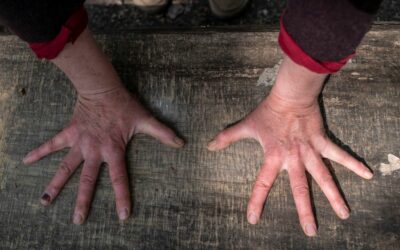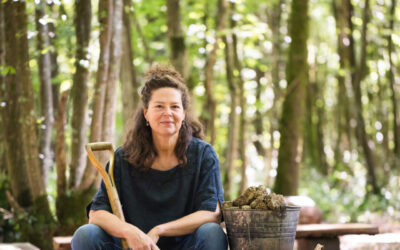Walking through Pearcelands Wood at Wakehurst Kew, on a quiet, mid-winter day; woods I know well from making a sculpture here a few years ago. As I walk, an open awareness of the trees, plants, creatures; the light and the weather… open to what might present itself as an idea for a new piece.
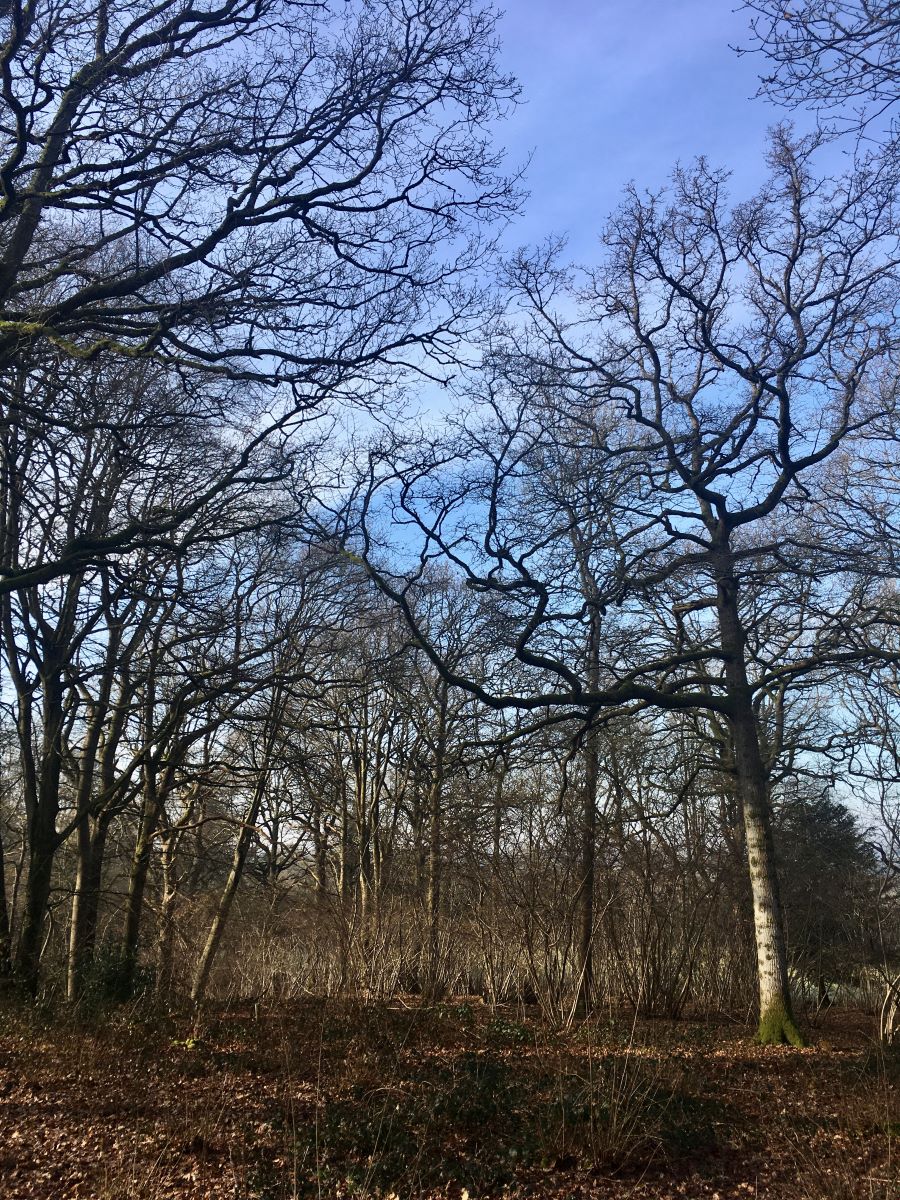
I’m interested in the relationship to place, to the community of plants and animals already there. How to work with minimal impact, to create with my own hands something of simple beauty that’s harmonious, celebratory, in relationship. Not imposing, but contributing, sharing the sense of what I perceive there.
Pausing to soak up the sight of several majestic oak and beech trees… multiple layers of texture, bare branches and subtle winter colours. A holloway, a sunken path made from centuries of human footfall, on the downwards slope of land… at the bottom a dark yew tree frames a bright circle of green pasture in the field beyond, strong contrast of light and colour.
I envisage hazels either side of the sunken path reaching across to entwine, creating a series of arches, embracing the space, leading towards the bright circle of green, to a space beyond.
Making
Returning in February to begin. A pair of secateurs, a small hand saw, a flask of hot tea.
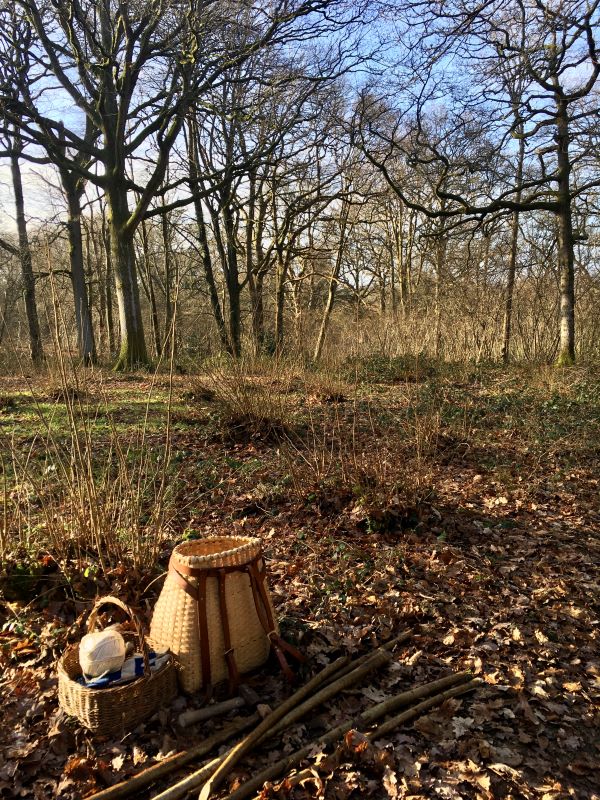
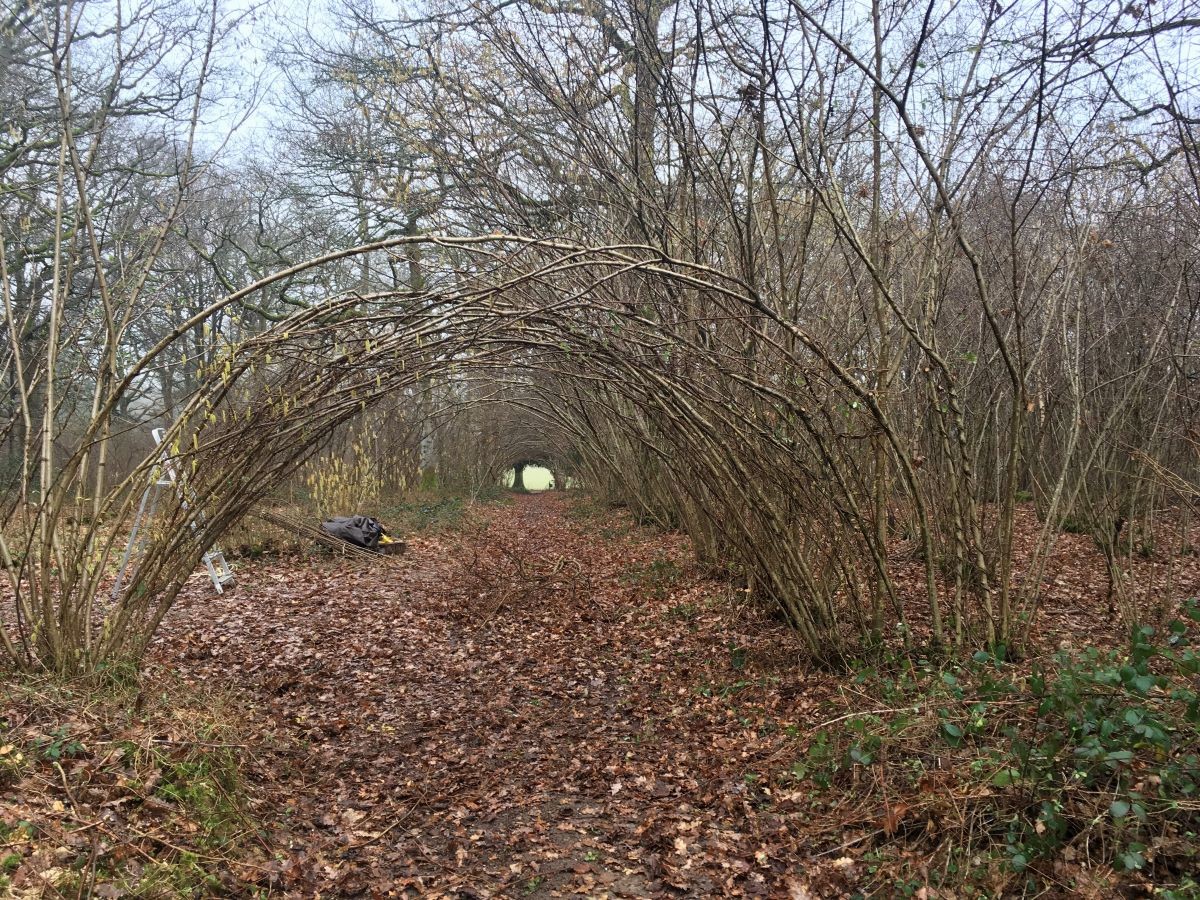
work in progress
I explore bending and interweaving the coppiced hazel, much of it 7 or 8 metres tall, from either side of the holloway. Weaving follows the growth pattern of the hazel; not contorted, twisted or wrapped tight, the weaving creates a natural, relaxed structure. Wherever honeysuckle grows up through the hazel, I incorporate it.
The inherent tension of bent and intertwined hazel rods creates stability. Ocassionally I use extra honeysuckle to secure the hazel… but mostly interweaving is sufficient, no other binding or securing: a simplicity of materials that is satisfying and congruent.
My focus is on having as light a touch with the weave as possible, leaving minimal evidence of human intervention, so that the arches look almost as if they were naturally growing this way.
I space the arches according to where the hazel stools are growing, and also with attention to the rhythm of the interlude between each arch as you move along the path beneath them.

late April bluebell carpet
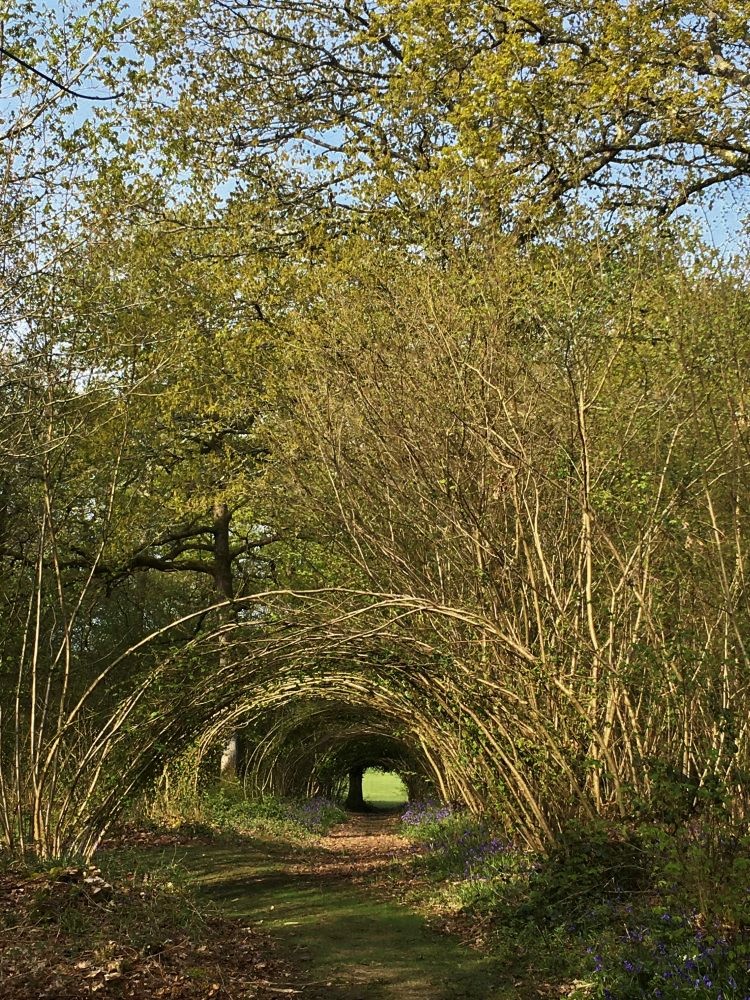
Hazel Holloway is a piece that could only exist here, in this specific place, because of the hazels, the oaks, the topography of these woods and fields, the hundreds of years of human footfall and human management of the coppice, the fauna that occupy this habitat, the fact that humans are in these woods less often these days.
Seasons
As time passes the hazel arches will continue to grow together. To one side, the recently coppiced hazel will grow and fill out with an understory of brambles, so that the arches become more integrated into, and secreted amongst, the vegetation.
Winter, spacious, filigree structures. Light pours down through bare branches above, where buzzards call from high.
Spring, a flush of new green, carpet of bluebells, the flitting and calling of small birds.
Summer, leafy tree canopy above, the arches themselves fully leafed. A sense of quiet containment, a darker, more secret arched walkway; bright green circle of light at its end.
Autumn, the path receives a blanket of fallen leaves, traces of human footfall covered over, space opens up.
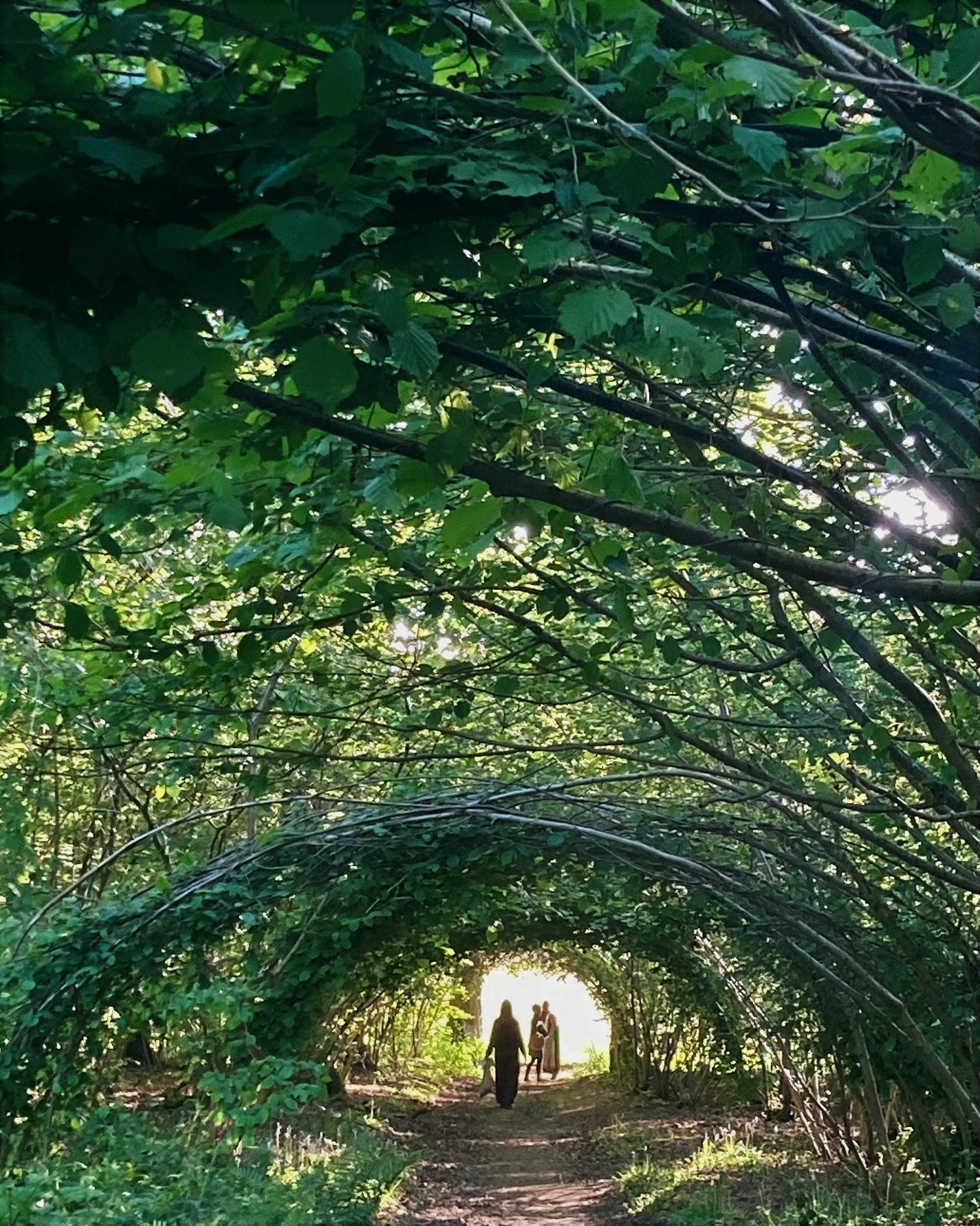
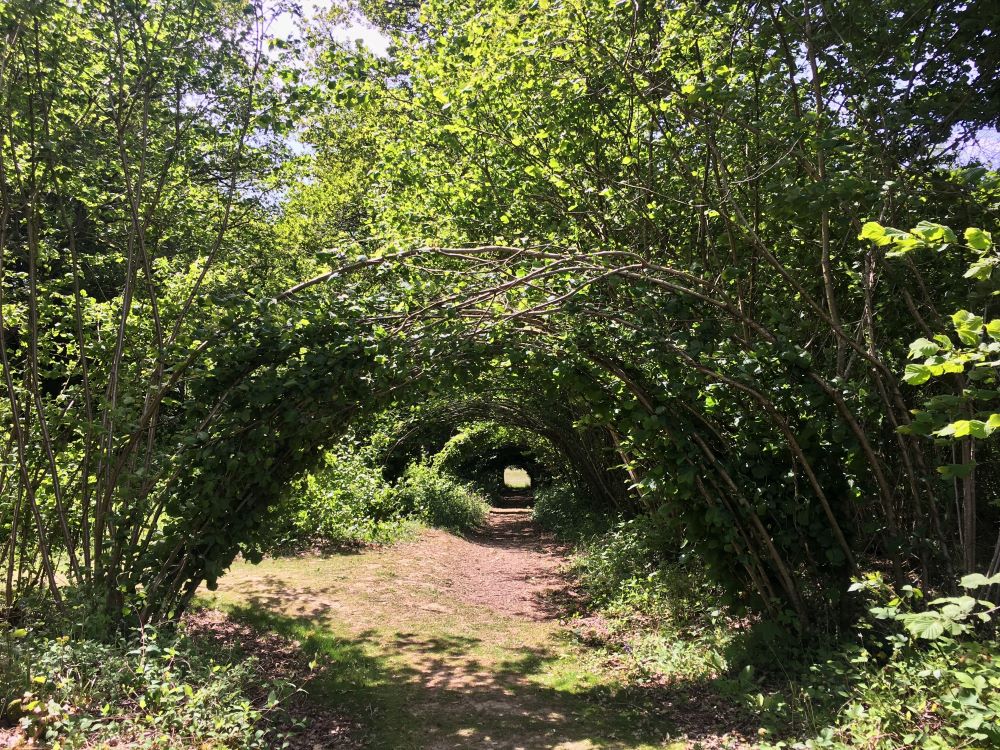
June verdancy
In the quiet of the woods, entering and walking barefoot beneath the arches, gradually moving towards an open space in the distance, there is stillness, reverie. Sensing how the light changes between these woven, growing arches; hearing rustles of wood mice in the leaf litter, song thrush singing from the top of an oak.
Maybe we lose ourselves as we enter a suspended space, reconnecting to where we truly belong, within the wider earth community, or as sculptor Antony Gormley puts it, the ‘wider world of creatureliness’.
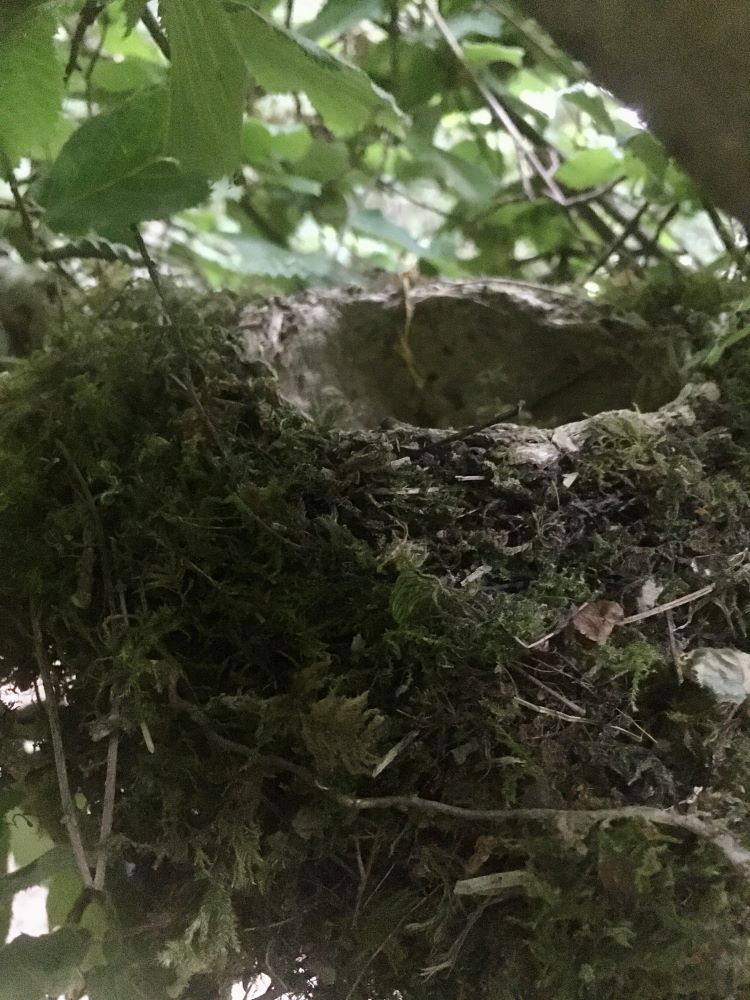
April: I spot the mossy clump of a nest tucked away high up in one of the hazel arches. Recently built (I know this because the moss is bright green), a thrush sits incubating her eggs, I can just see her tail.
Returning in June, the nest is empty, hopefully a successful brood fully fledged. I inspect it closely this time… a perfectly shaped mud-lined interior hidden deep in the mossy, leafy clump.
Birds choosing to nest in an archway I created…. possibly the most affirming response an artist could wish for.
make a poem that does not disturb the peace from which it came
Wendell Berry
Place
Land: Wakehurst abuts the London to Brighton Way Roman road, which passes through the iron-producing areas of the Weald. The land here slopes down into the Loder valley, to waterways which join the River Ouse further downstream. There’s a long history of this area of land being inhabited, undoubtedly well before the Romans.
Coppice: an ancient practice, dating back to at least Neolithic times, of managing woodland to produce sustainable wood products (poles for buildings, baskets, pole lathing, charcoal making etc). It opens up glades in woodland which allows a great diversity of fauna and flora. There are records of Pearcelands being coppiced for the last few hundred years (probably going on for much longer than that); the hazel stools here have been carefully managed and are very productive.
Birds: first day, laying on my back at a tea break gazing upwards, a couple of buzzards soaring in the clear cold sky. And another bird I don’t recognise. Talking with groundsman Steven, a knowledgeable naturalist, he’s heard reports of a goshawk in the area. Researching, I learn that goshawks, usually highly elusive and rarely seen (famous as incredible hunters), do aerial displays in Feb/March. On subsequent days, more goshawk encounters: seen in flight skimming the tree tops; being mobbed by corvids through the tree canopy; hearing its rasping call.
A friend in Cumbria tells me of a local man who regularly hunts with his female goshawk; he’s known as Jimmy Three Fingers, on account of his bird ‘getting a bit feisty’ one day.
A flock of long tailed tits regularly passes through at the top of the holloway, perching on the first hazel arch as they follow each other to the large nearby oak for feeding. Liquid songs of blackbird and song thrush; chiffchaffs and great tits with their repetitive calls.
Honeysuckle and dormice: hazel dormice (rare and protected) live here in Pearcelands. They’re mainly arboreal and use honeysuckle bark for their nests. They eat berries, nuts, young leaves, insects and caterpillars… and honeysuckle flowers. I like to think of them moving amongst the hazel arches collecting honeysuckle bark and eating the flowers.
Honeysuckle and Seahenge: a 4,000 year old monument, revealed by the tides, off the Norfolk coast. Split oak trunks set in a circular structure, with a mature, upside-down oak, in the centre. Much speculation about this fascinating arrangement. Fragments of honeysuckle fibres remain, used as rope to secure the central, inverted oak stump.
I’m curious about how long the honeysuckle bindings on these hazel arches may last.
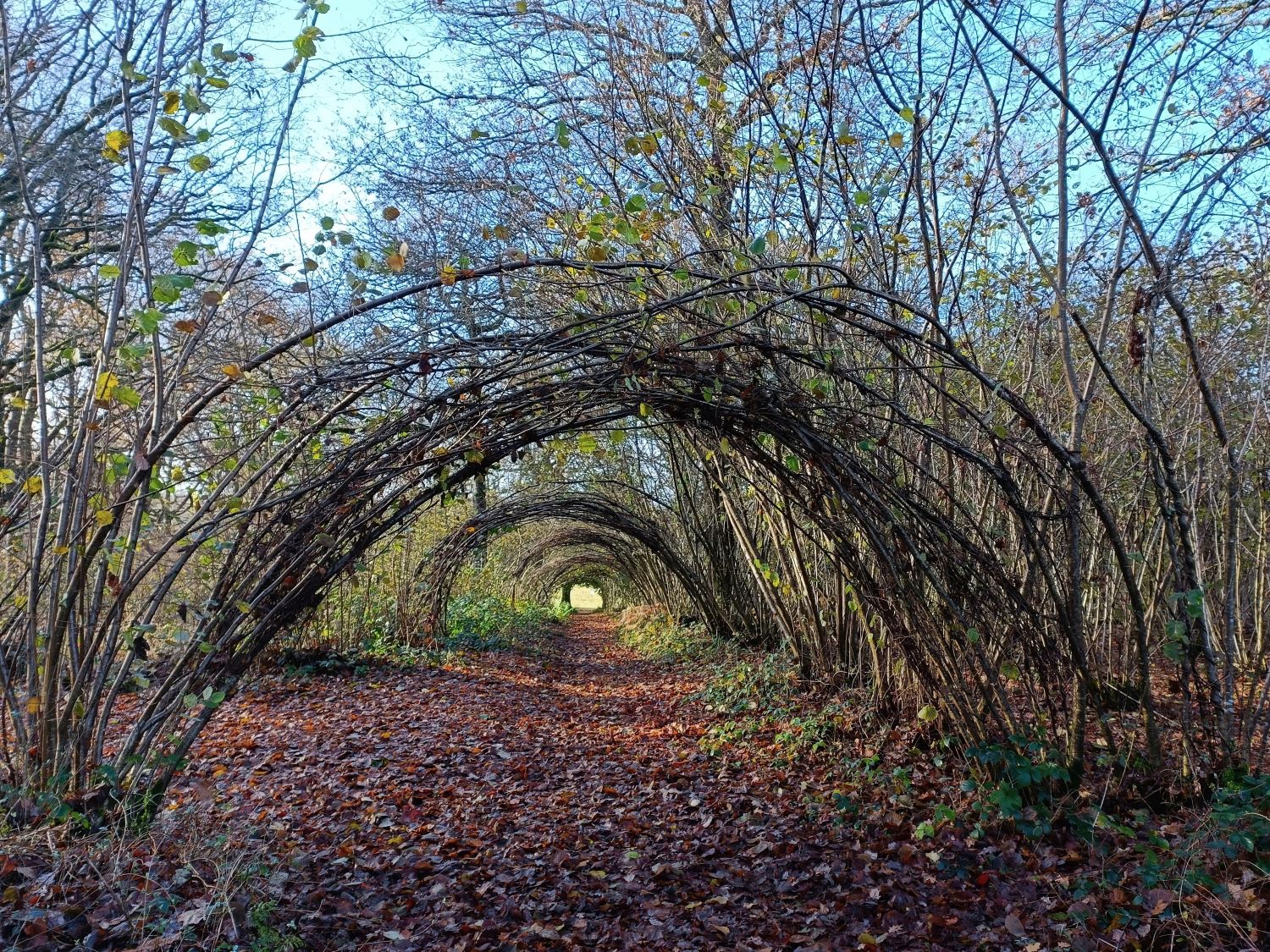
the quiet of December
Hazel Holloway can be viewed at Wakehurst (in Pearcelands Wood), Sussex, as part of general admission to Wakehurst. Visitor details.
With heartful thanks to Iain Parkinson
